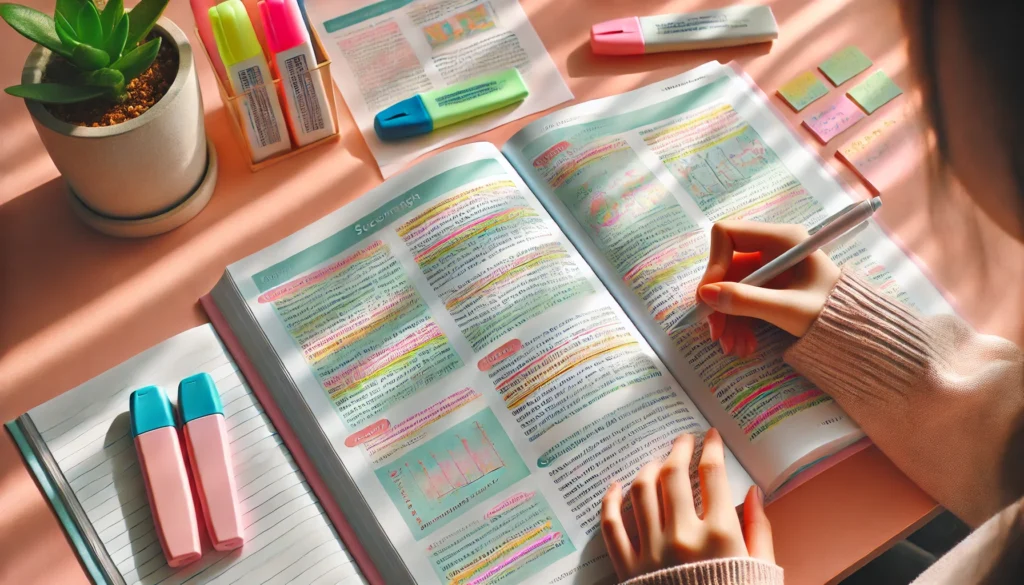Imagine this: You’ve got a textbook in front of you, filled with dense, complex material. You start reading, but halfway through, you realize you haven’t absorbed much of anything and frustration sets in. You’re not alone—many students face this challenge. But what if there was a way to systematically approach textbook study that could transform how you learn?
This article introduces a powerful textbook study protocol designed to help you effectively absorb, retain, and apply the information you read. By following this structured approach, you’ll not only enhance your comprehension but also ensure that what you learn sticks with you for the long haul.
Phase 1: Pre-Reading Preparation – Set the Stage for Success
We’ve all been there – diving headfirst into a chapter without any preparation, only to realize we’ve missed crucial details. It’s like trying to build a house without a blueprint or embarking on a road trip without a map. You might eventually get where you need to go, but the journey will be longer, more frustrating, and less efficient than it needs to be. Let’s change that approach to textbook study.

Preview the Chapter
Before you read a single word of the main text, take a few minutes to skim the chapter. This isn’t just a cursory glance – it’s a strategic overview that sets the stage for effective learning. Here’s how to do it:
- Read the chapter title and introduction: This gives you a broad idea of what to expect.
- Scan the headings and subheadings: These are like signposts that outline the main ideas and their hierarchy.
- Look at bold or italicized terms: These are usually key concepts or vocabulary that you’ll need to understand.
- Examine any visual aids: Charts, diagrams, graphs, and images often convey complex information succinctly.
- Read the chapter summary or conclusion: This provides a concise overview of the main points.
This quick overview builds a mental framework for the information you’re about to learn. It’s like looking at the picture on a puzzle box before you start assembling the pieces – you have a clearer idea of what you’re working towards.
Set a Purpose
Ask yourself: “What do I need to learn from this chapter?” Having clear learning objectives focuses your attention on what’s truly important. This step is crucial because it transforms passive reading into active, goal-oriented study.
To set effective purposes, consider:
- Your course objectives: What does your syllabus say you should learn from this material?
- Upcoming assignments or exams: How might this chapter’s content be applied or tested?
- Your personal interests: What aspects of this topic intrigue you most?
Write down 2-3 specific learning objectives for the chapter. For example, if you’re studying a chapter on photosynthesis, your objectives might be:
- Understand the main stages of photosynthesis
- Identify the key molecules involved in the process
- Explain how environmental factors affect photosynthesis rates
Create Questions
Turn those headings and subheadings into questions. This technique, known as self-questioning, is a powerful way to engage with the text actively. For example:
- If a section is titled “The Stages of Mitosis,” ask yourself, “What are the stages of mitosis, and what happens in each stage?”
- For a heading like “Factors Affecting Climate Change,” your question might be, “What are the primary factors contributing to climate change, and how do they interact?”
This primes your brain for active learning, making you more likely to notice and remember the answers as you read. It also helps you monitor your comprehension – if you can’t answer these questions after reading the section, you know you need to review.
Actionable Tip: Spend 5-10 minutes on this pre-reading phase. It might feel like you’re wasting time, but trust me, it’ll pay off in more efficient and effective reading later. Consider it an investment in your learning – a small time commitment upfront that yields significant returns in comprehension and retention.

Phase 2: Active Reading – Engage Deeply with the Text
Let me share a quick story. Mike, a struggling physics student, always felt lost in the sea of equations and theories. Each chapter seemed like an impenetrable fortress of complex ideas. That is, until he learned to actively engage with his textbook. Suddenly, those walls of text transformed into manageable, even interesting, chunks of information. His grades improved, sure, but more importantly, he started to see physics everywhere in his daily life. That’s the power of active reading in textbook study.
P2R System Implementation
The P2R system (Preview, Read, Review) is a powerful strategy for breaking down content:
- Preview: We’ve already covered this in Phase 1, but it’s worth reiterating. This step sets the stage for everything that follows.
- Read: Now it’s time to dive into the text, focusing on one section at a time. But this isn’t passive reading – it’s an active process:
- Read with your questions in mind
- Take notes in your own words
- Make connections to things you already know
- Pause periodically to summarize what you’ve read
- Review: After each section, take a moment to summarize what you’ve just read in your own words. This isn’t just regurgitating the text – it’s about processing and internalizing the information.
PQ4R Enhancement
Take the P2R system a step further with the PQ4R method:
- Preview: As we’ve discussed.
- Question: Turn headings into questions, as we did in Phase 1.
- Read: Actively engage with the text, seeking answers to your questions.
- Reflect: Think about how this new information relates to what you already know. How does it fit into the bigger picture of the subject?
- Recite: Without looking at the book, recite the main points out loud. This verbal rehearsal strengthens neural connections and improves recall.
- Review: Go over the material again, focusing on any points you struggled to recite.
The added steps of reflecting on how the material relates to what you already know and reciting key points out loud can cement the material in your memory. It might feel awkward at first, but speaking the information engages multiple senses and learning pathways, enhancing retention.
Engage with Visual Aids
Don’t skip over diagrams, charts, or graphs. These visual aids often convey complex information more effectively than text alone. Here’s how to make the most of them:
- Study the title and caption: These often provide crucial context.
- Examine the components: What do the different parts represent?
- Look for patterns or trends: What’s the overall message?
- Connect to the text: How does this visual relate to what you’ve read?
- Try to recreate it: Can you sketch a simplified version from memory?
Remember, these visuals aren’t just illustrations – they’re concentrated packets of information designed to enhance your understanding.
Break It Down
Rome wasn’t built in a day, and you can’t conquer a textbook in one sitting. Divide the content into manageable sections. This prevents cognitive overload and keeps you motivated with a sense of progress.
Try the Pomodoro Technique:
- Choose a task (like reading a section of your textbook)
- Set a timer for 25 minutes
- Work on the task until the timer rings
- Take a short 5-minute break
- Every four “Pomodoros,” take a longer break (15-30 minutes)
This technique helps maintain focus and prevents burnout. It also provides natural break points for review and reflection.
Optional Strategy: Read Aloud
For particularly difficult sections, try reading aloud. This engages both visual and auditory learning pathways, potentially enhancing comprehension. It’s especially useful for:
- Complex sentences that are hard to parse silently
- Important definitions or key concepts
- Passages you’ve read multiple times without understanding
Reading aloud forces you to slow down and consider each word, which can help you catch nuances you might have missed when reading silently.

Phase 3: Post-Reading Review – Reinforce and Apply Your Knowledge
Here’s a sobering thought: without review, we forget about 40% of what we’ve learned within the first 24 hours. Within a week, that number jumps to 90%. Yet, post-reading activities are often the most overlooked part of textbook study. It’s like spending hours cooking a gourmet meal and then forgetting to eat it. Let’s change that.
Review Notes
Go back through your notes. This isn’t just rereading – it’s active recall. Try to elaborate on your notes, filling in any gaps from memory. Here’s a structured approach:
- Read through your notes without referring to the textbook
- Identify any areas where your notes are unclear or incomplete
- Try to fill in these gaps from memory
- Only after attempting this should you refer back to the text for verification
This process helps you identify what you’ve truly internalized and what needs more work. It also reinforces the neural pathways associated with this information, strengthening your memory.
Answer Your Questions
Remember those questions you created during the preview phase? Now’s the time to answer them. If you can’t, you know exactly what areas need more review.
Take it a step further:
- Write out full answers to each question
- Create new questions based on the content you’ve learned
- Try to anticipate potential exam questions and answer those
This process not only reinforces your learning but also helps you start thinking like your instructor, which can be invaluable when it comes to exams.
Practice Problems
Knowledge isn’t just about remembering – it’s about applying. Tackle those end-of-chapter problems. They’re not busy work; they’re your chance to put theory into practice. Here’s how to make the most of them:
- Attempt the problems without referring to the chapter first
- Check your answers and note any mistakes
- For incorrect answers, try to identify where you went wrong before looking at the solution
- If you’re still stuck, review the relevant section of the chapter
- Attempt similar problems to ensure you’ve mastered the concept
Remember, struggle is where the real learning happens. If you can only do the problems with the book open, you haven’t truly mastered the material yet.
Teach the Material
Ever heard the phrase, “To teach is to learn twice”? Try explaining what you’ve learned to a study buddy or even an imaginary student. If you can teach it, you truly understand it.
Here are some ways to implement this:
- Create a mini-lecture on the topic
- Write a blog post explaining the concept in simple terms
- Record a video explaining a key process or idea
- Draw a concept map linking all the main ideas from the chapter
This process forces you to organize the information logically, identify key points, and explain complex ideas in simple terms – all valuable skills for deepening your understanding.
Review Again
Implement spaced repetition. Review the material again after a day, then a week, then a month. This technique is scientifically proven to boost long-term retention. It works by reinforcing the neural pathways just as they’re starting to weaken, strengthening them each time.
A simple spaced repetition schedule might look like this:
- First review: Same day as initial study
- Second review: Next day
- Third review: After 3 days
- Fourth review: After a week
- Fifth review: After 2 weeks
- Sixth review: After a month
Each review doesn’t need to be extensive – even a 10-15 minute refresher can make a big difference.
Actionable Tip: Set a calendar reminder for a quick review session a few days after your initial study. Even 15 minutes can make a big difference in retention. Use this time to quickly go over your notes, answer a few key questions, and refresh your memory on the main concepts.

General Strategies – Build Sustainable Study Habits
Let me tell you about Alex. Alex was a C-student who barely scraped by each semester. Textbook study was a chore, something to be endured rather than enjoyed. But when he started incorporating these strategies into his routine, something amazing happened. His grades improved, sure, but more importantly, he started to enjoy learning. He wasn’t just memorizing facts; he was understanding concepts and seeing how they applied to the real world. Textbook study became less of a burden and more of an opportunity for growth and discovery.
Consistent Study Schedule
Your brain thrives on routine. Set regular study times and stick to them. It’s like training for a marathon – consistency is key. Here’s how to create an effective study schedule:
- Identify your most productive hours. Are you a morning person or a night owl?
- Block out specific times for studying each subject.
- Allow for breaks and flexibility, but try to stick to your schedule as much as possible.
- Review your schedule weekly and adjust as needed.
Remember, the goal is to make studying a habit, as natural as brushing your teeth or having breakfast.
Optimal Environment
Create a distraction-free zone for studying. This might mean finding a quiet corner of the library or investing in some noise-canceling headphones. Your study environment should be:
- Well-lit to reduce eye strain
- Comfortably cool (around 70°F or 21°C is ideal for most people)
- Equipped with a comfortable chair and desk at the right height
- Free from clutter and unnecessary distractions
Consider having a dedicated study space. This helps your brain associate that area with focused work, making it easier to get into “study mode” when you sit down.
Stay Organized
Keep your study materials tidy and easily accessible. Digital tools like Evernote or OneNote can be great for organizing notes and resources. Here are some organizational tips:
- Use color-coding for different subjects or types of information
- Create a filing system for handouts and papers
- Keep a master calendar with all your deadlines and exam dates
- Use bookmarks or sticky notes to mark important pages in your textbooks
- Clean up your study area at the end of each session
Remember, an organized space leads to an organized mind.
Stay Positive and Motivated
Maintain a growth mindset. Remember, your ability to learn isn’t fixed – it grows with effort. Celebrate small victories along the way to stay motivated. Here are some strategies:
- Set small, achievable goals for each study session
- Reward yourself after completing challenging tasks
- Visualize your success and the benefits of mastering the material
- Practice positive self-talk. Instead of “I can’t do this,” try “I can’t do this yet.”
- Take care of your physical health through exercise, proper nutrition, and adequate sleep
Remember, struggling with difficult material doesn’t mean you’re not capable. It means you’re growing and learning.
Use Technology
Complement your textbook learning with apps like Anki for flashcards or Khan Academy for video explanations. Just be sure technology enhances rather than distracts from your learning. Here are some tech tools to consider:
- Quizlet for creating and studying flashcards
- Forest app for staying focused and avoiding phone distractions
- Notion for organizing notes and creating a personal knowledge base
- Pomodoro timer apps for managing study sessions
- Mind mapping tools like MindMeister for visual learning and brainstorming
Remember, these tools are meant to support your learning, not replace traditional study methods.
As the great Bruce Lee once said, “I fear not the man who has practiced 10,000 kicks once, but I fear the man who has practiced one kick 10,000 times.” The same principle applies to learning. It’s not about cramming everything at once, but about consistent, deliberate practice. Each time you engage with the material, you’re not just memorizing facts – you’re building neural pathways, deepening your understanding, and developing critical thinking skills that will serve you well beyond any single exam or course.
Conclusion
We’ve covered a lot of ground, from setting the stage with pre-reading preparation to engaging deeply with the text and reinforcing your knowledge through review. Remember, this isn’t just about acing your next exam. It’s about developing a skill that will serve you for a lifetime – the ability to learn effectively from any resource.
These textbook study techniques might feel awkward or time-consuming at first. That’s normal. Learning to learn is a skill like any other – it takes practice. But as you incorporate these strategies into your routine, you’ll find that they become second nature. You’ll start to approach your textbooks with curiosity rather than dread, seeing them as gateways to knowledge rather than obstacles to overcome.
Moreover, these skills extend far beyond the classroom. In our rapidly changing world, the ability to quickly and effectively learn new information is invaluable. Whether you’re starting a new job, picking up a new hobby, or just trying to understand the latest developments in your field, these techniques will serve you well.
The next time you open a textbook, don’t just read it. Engage with it. Question it. Make it yours. Your future self will thank you for the knowledge and skills you’re building today.
Now, I challenge you: implement this protocol in your next textbook study session. Pay attention to how it changes your learning experience. And don’t keep it to yourself – share your experiences. After all, learning is a journey best shared with others.
Happy studying!
To Further enhance your study skills here are two articles that with strategies that pair well the the Textbook Study Protocol:
These 10 steps are all you need to learn anything fast – Learning Forge
Top 10 Learning Techniques for Rapid Skill Acquisition – Learning Forge
